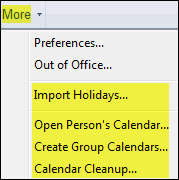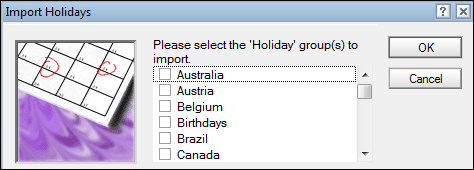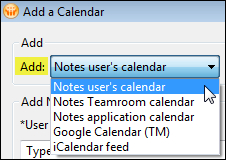Under the More button we can find some tools that are very useful. We have already discussed Preferences. In this section we will learn about importing holidays, opening other people's calendars, and calendar cleanup. We will discuss Group Calendars in another section.

Just the word "holidays" makes this feature sound great and it is indeed a great feature. Our IT Department can customize predefined holiday sets that are provided within Lotus Notes. We can then add them to our calendar. Holidays are typically categorized by country, although our IT Department could include regional holidays as well.
The following is the Import Holidays dialog box:

Each time we import, we will be prompted with what was added, updated, and what was deleted. At any time we want, we can import holidays and, if there have been any changes, these will be reflected in our calendar. We can also import another countries' holidays into our calendar. If we want to remove that country, we need to do the import, select our country only, and the additional country will be removed.
There may be times when we need to open one of our colleague's calendar. They must give us access before we are able to open their calendar. When we select Open Person's Calendar, we will be prompted with the Corporate Directory. We need to select the person's name then the OK button. That person's calendar will open so that we are able to view it.
If we need to access the person's calendar on a regular basis, we can create a bookmark to their calendar in our Open button. To bookmark, drag the window tab of the opened calendar to the Open button.
Our calendars can be very busy and have lots of entries in them. We may want to cleanup old entries to reduce the space in our mail file or simply just tidy up. If we delete old entries, we run the risk of deleting future calendar entries if we have deleted a repeating appointment or anniversary, and so on. We can delete past calendar and To Do entries in a safe manner using the Calendar Cleanup tool.
To delete past calendar or To Do entries, we need to follow these steps:
- Open the calendar or To Do.
- Click More and then Calendar Cleanup.
- Select which entries we want to delete by selecting Entries older than or Entries occurring before.
- Select whether we want to delete Calendar and or To Do entries.

We can import and export iCalendar-based calendars to and from Lotus Notes.
iCalendar is an Internet standard that allows calendars created in different calendar products to be imported into, and then viewed and managed in, other calendar products that use the iCalendar standard. The iCalendar standard also allows for the sending and receiving of meeting requests and other tasks via e-mail.
When a calendar is imported, the imported calendar entries are placed in the user's calendar and Lotus Notes creates an Imported Calendar document from which Notes users can manage the imported calendar. The Imported Calendar document contains the calendar name, a source field containing the path that specifies the location of the calendar file, and the date on which the calendar was imported into Notes. Imported calendar entries display in the user's Notes calendar as appointments, all-day events, anniversaries, or reminders.
From the Calendar Information document, users can manage their imported calendars in these ways:
- Delete a calendar using the Delete button
- Rename a calendar using the editable field
The Imported Calendar documents can be accessed through the Imported Calendars view. From this view, Notes users can view imported calendars, delete imported calendars, and import new calendars. To open the Imported Calendars view, we need to click More above the Notes calendar and then click Manage Imported Calendars. Notes users must upgrade their mail template to at least version 7.0.2 to use any of the new iCalendar import and export features.
If a user attempts to import a previously imported calendar, an information box indicates that the calendar already exists and asks whether to continue or cancel the import. The user can preview the calendar being imported prior to specifying whether to continue or cancel the import. If the user chooses to continue importing the calendar, the newly imported calendar overwrites the previously imported calendar.
Users can import iCalendar files with a maximum of 500 documents; multiple imports are required for more than 500 documents.
Notes also allows users to export their calendars by using File | Export to export all or selected calendar entries.
We can manage our imported calendars by following these steps:
- Above the Notes calendar, we need to click the More button and then Manage Imported Calendars.
- Do any of the following:
- To delete one or more calendars, select the calendars to delete, click Delete, and then click Yes.
- To edit a calendar's name, double-click the name of the calendar. Then click Edit, type a new calendar name, and click OK.
- To import a new calendar, click Import New Calendar. Then select Calendar File (.ics) in the Files of type field, select the .ICS file to import, and click Import.

We can add many types of calendars to our Notes calendar, display their entries alongside our Notes calendar's entries (overlay them), and set display options to distinguish each calendar's entries from each other. I work with another trainer in my organization and I have overlaid their calendar onto mine so that when we are scheduling training I can see when we are either available or booked. I only tick to show my colleagues calendar when I am scheduling; all other times I have it deselected so that it doesn't show on my calendar.
- In the Views panel of the calendar's navigator, expand Show Calendars.
- Click Add a Calendar.
- Under the Add drop-down box, select one of the options. Depending on the option we select, different fields will be required to be filed in. We then need to complete the Add fields for the Add option we selected.

Let's now see each option under the Add drop down.
- Notes user's calendar: Adds another person's Notes calendar (requires that the person has given you access to their calendar). Type the person's name to search for them.

- Notes Teamroom calendar: Adds any Notes Teamroom that has a calendar. Enter the Label name (name of Teamroom) or URL into the appropriate fields and then click the Lookup button. A Teamroom application is used for teams to collaborate documents, calendars, and discussions.

- Notes application calendar: Adds any Notes application that has a calendar. We need to browse to the application and then select the application's calendar view. It is the same process as adding a TeamRoom calendar as above.
- Google Calendar (TM): Adds a private calendar (which requires a user name and password) or a public calendar (which requires the calendar's URL).
- iCalendar feed: Adds an iCalendar feed (requires the feed's Web address).

- Notes user's calendar: Adds another person's Notes calendar (requires that the person has given you access to their calendar). Type the person's name to search for them.
- Under Calendar Entry Formatting, select display options to make the display of the added calendar's entries on your Notes calendar unique. Select background color, text color, and entry icon.
- Click OK. If the calendar we're adding contains many entries, it may take a little longer for our Notes calendar to display them.
- We can deselect to hide the calendar we just added and then select it again when we need it.

